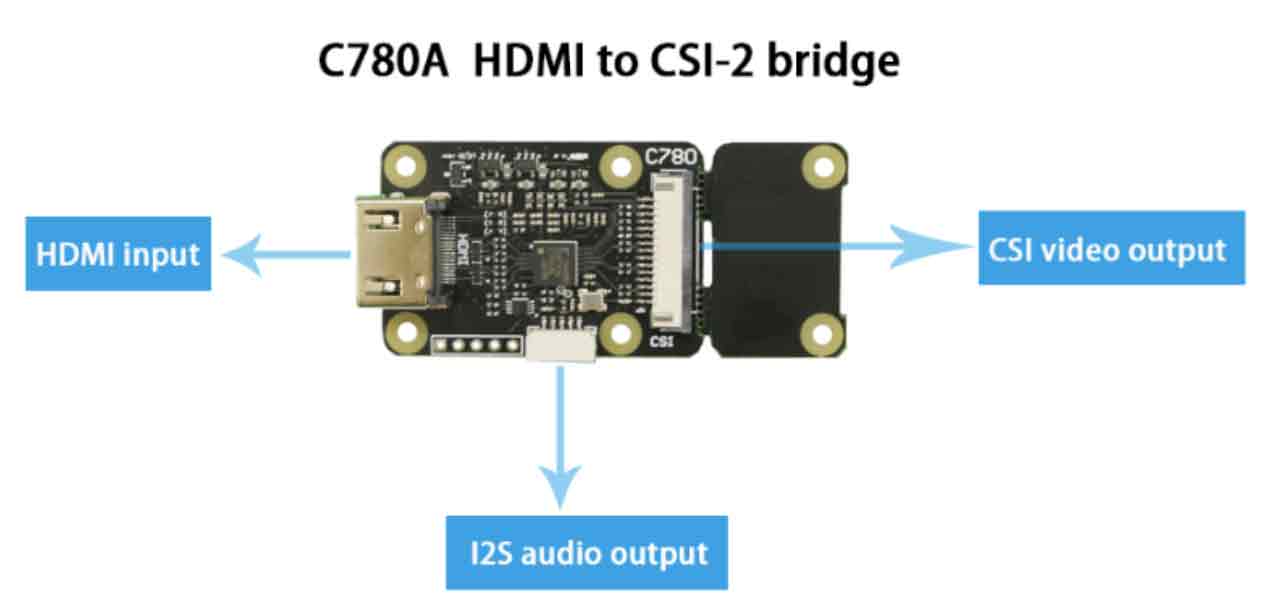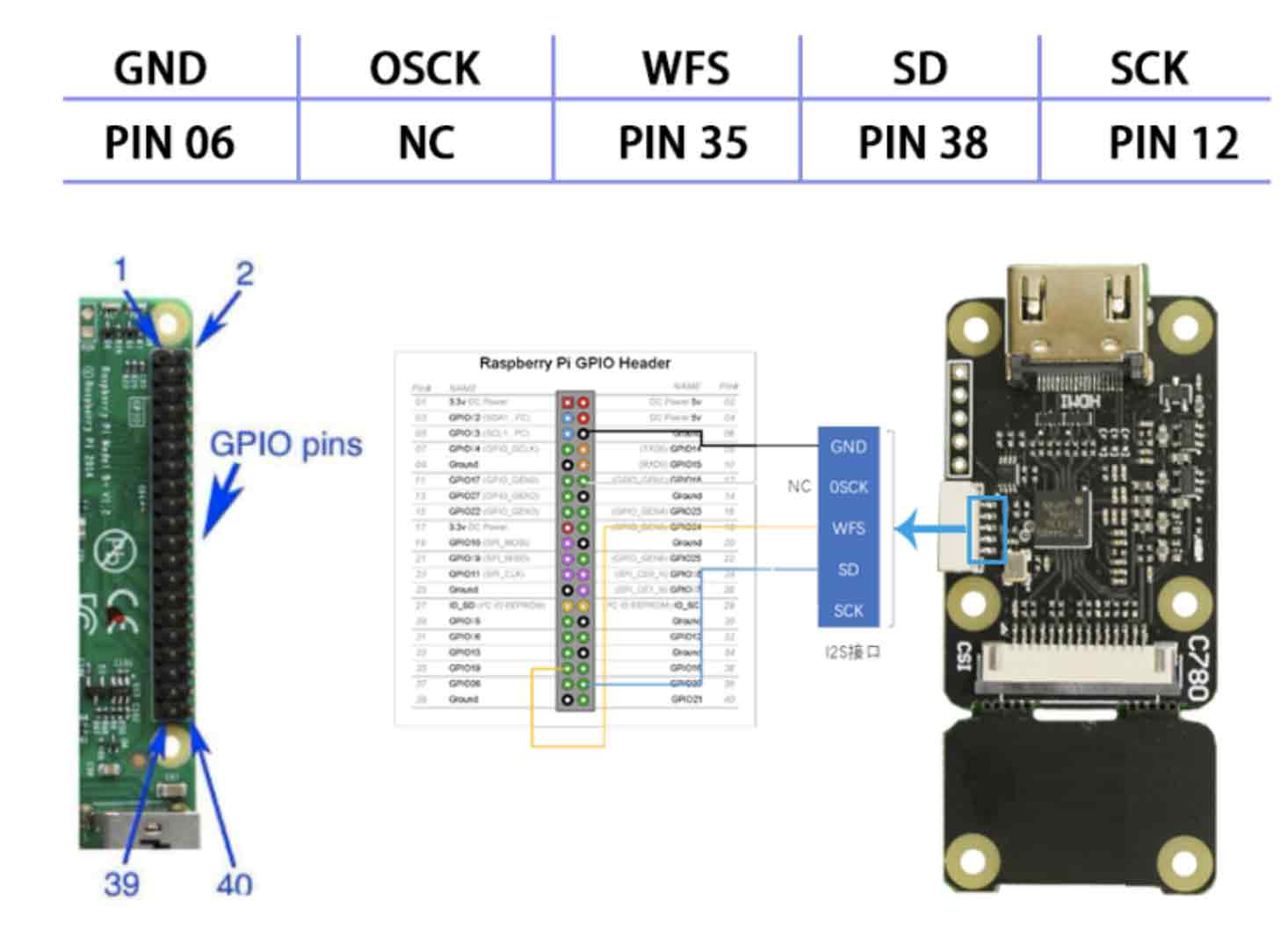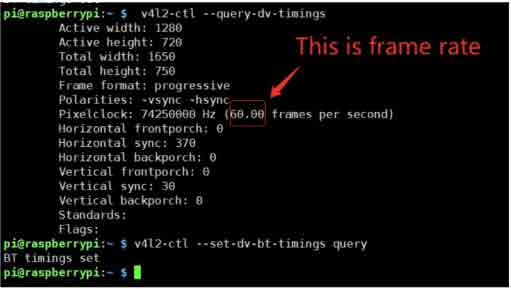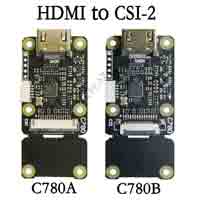- sales/support
Google Chat: zj734465502@gmail.com
- sales
+86-0755-88291180
- sales01
sales@spotpear.com
- sales02
dragon_manager@163.com
- support
tech-support@spotpear.com
- CEO-Complaints
zhoujie@spotpear.com
- sales/support
WhatsApp:13246739196
Raspberry Pi HDMI to CSI&I2S User Guide
C780A hardware parameters
- HDMI input: supports up to 1080P50Hz on raspberry pi(Limited by the number of CSI-2 channels)
- HDMI to CSI-2 bridge chip:Toshiba TC358743XBG
- 2 CSI-2 channels & clock
- CSI-2 interface: 15 pin FPC seat, spacing 1.0 mm
- Size: 30 x 65 mm (unbroken PCB size); 30 x 45 mm (PCB size after breaking)
- Install:6 x M2.5
- Power supply:3.3V
- Weight: 10g
C780B hardware parameters
- HDMI input: supports up to 1080P60Hz on raspberry pi
- HDMI to CSI-2 bridge chip:Toshiba TC358743XBG
- 4 CSI-2 channels & clock
- CSI-2 interface: 22 pin FPC seat, spacing 0.5 mm
- Size: 30 x 65 mm (unbroken PCB size); 30 x 45 mm (PCB size after breaking)
- Install:6 x M2.5
- Power supply:3.3V
- Weight: 10g
Interface

The wiring of audio part is shown in Figure.

Software demo
The use guide of C790/C780/C779 depends on the official Raspberry Pi OS version you are using. Different versions have different usage methods. If you have some questions, Please contact us, we will provide you with technical services.
To use the kernel drivers, please update your system. There are a few things that have changed with the 5.4 kernel, so these instructions are for 5.4 or later. If “uname -a” reports anything less, then fix this before proceeding.
1. Update & upgrade the raspberry pi system (It will take a long time depend on the different country)
pi@raspberrypi:~ $ uname -a
Linux raspberrypi 5.10.63-v7l+ #1459 SMP Wed Oct 6 16:41:57 BST 2021 armv7l GNU/Linux
2. Enable camera module (the camera is enabled by default in Raspberry pi Bullseys OS)
sudo raspi-config
sudo reboot
Navigate to ‘Interfacing Options’ and hit Enter. Now select the ‘Camera’ option, and hit the Enter key to enable it. Select “Finish” and select to reboot your Raspberry Pi. reboot is important!!
3. Edit /boot/config.txt (that will need sudo)
sudo nano /boot/config.txt
Add the line:
dtoverlay=tc358743
Add the line if your shield support audio like C780 or C790.
dtoverlay=tc358743-audio
please append the If (and only if) you have a device such as the C780 or C790 that supports the 22pin connector with all 4 lanes wired out, and are using a Compute Module with the CAM1 connector that also has all 4 lanes wired up, you can use:
dtoverlay=tc358743,4lane=1
!!! note "4. Check the amount of memory assigned to the CMA heap with “dmesg | grep cma”. The first line should be along the lines of"
pi@raspberrypi:~ $ dmesg | grep cma
[0.000000] cma: Reserved 256 MiB at 0x000000001ec00000
If it reports less than 96MB assigned to CMA, then edit /boot/cmdline.txt and add to the start of the line. Do NOT add any carriage returns.
cma=96M
!!! note "5. Reboot. If all is well you should get a /dev/video0 device, and “v4l2-ctl –list-devices” will tell you that it is provided by Unicam. After connecting all the cables, power on the Raspberry Pi, the C790 indicator light is normally green, and after opening the Raspberry Pi terminal, enter the following command:"
pi@raspberrypi:~ $ ls /dev/video0
/dev/video0
pi@raspberrypi:~ $ v4l2-ctl --list-devices
bcm2835-codec-decode (platform:bcm2835-codec):
/dev/video10
/dev/video11
/dev/video12
/dev/video18
/dev/media1
bcm2835-isp (platform:bcm2835-isp):
/dev/video13
/dev/video14
/dev/video15
/dev/video16
/dev/media0
unicam (platform:fe801000.csi):
/dev/video0
/dev/video1
/dev/media2
!!! note "6. This driver puts all the control in the hands of the user, or the user’s application. By default there is no EDID loaded into the chip to allow it to tell the HDMI source what resolutions are supported. There are EDID editors around. If you create a file edid.txt, then you can push this to the device using" The comment of edid.txt file:
00ffffffffffff005262888800888888
1c150103800000780aEE91A3544C9926
0F505400000001010101010101010101
010101010101011d007251d01e206e28
5500c48e2100001e8c0ad08a20e02d10
103e9600138e2100001e000000fc0054
6f73686962612d4832430a20000000FD
003b3d0f2e0f1e0a2020202020200100
020321434e041303021211012021a23c
3d3e1f2309070766030c00300080E300
7F8c0ad08a20e02d10103e9600c48e21
0000188c0ad08a20e02d10103e960013
8e210000188c0aa01451f01600267c43
00138e21000098000000000000000000
00000000000000000000000000000000
00000000000000000000000000000000
cd ~
sudo nano edid.txt
#copy the above commend in edid.txt, save&exit;
pi@raspberrypi:~ $ v4l2-ctl --set-edid=file=edid.txt --fix-edid-checksums
CTA-861 Header
IT Formats Underscanned: yes
Audio: yes
YCbCr 4:4:4: no
YCbCr 4:2:2: no
HDMI Vendor-Specific Data Block
Physical Address: 3.0.0.0
YCbCr 4:4:4 Deep Color: no
30-bit: no
36-bit: no
48-bit: no
CTA-861 Video Capability Descriptor
RGB Quantization Range: yes
YCC Quantization Range: no
PT: Supports both over- and underscan
IT: Supports both over- and underscan
CE: Supports both over- and underscan
7. The driver does NOT automatically switch to the resolution detected. Use the command:
pi@raspberrypi:~ $ v4l2-ctl --query-dv-timings
Active width: 1280
Active height: 720
Total width: 1650
Total height: 750
Frame format: progressive
Polarities: -vsync -hsync
Pixelclock: 74250000 Hz (60.00 frames per second)
Horizontal frontporch: 0
Horizontal sync: 370
Horizontal backporch: 0
Vertical frontporch: 0
Vertical sync: 30
Vertical backporch: 0
Standards:
Flags:
You MUST set the timings via “v4l2-ctl –set-dv-bt-timings”. You can pass in an index to the detected mode, or use:
v4l2-ctl --set-dv-bt-timings query
to select the currently detected timings.
v4l2-ctl -V
should now reflect the resolution detected.
8. The chip supports two formats – BGR3 (the default) and UYVY. BGR3 is 24bpp, and UYVY is YUV4:2:2 16bpp.
Over the normal 2 CSI-2 lanes the data rate is such that BGR3 can run at a maximum of 1080p30, whilst UYVY will go up to 1080p50. Use the following command to select UYVY, however your application may override that.
v4l2-ctl -v pixelformat=UYVY
9. Check that the audio drivers / card is available to ALSA.
pi@raspberrypi:~ $ arecord -l
**** List of CAPTURE Hardware Devices ****
card 1: tc358743 [tc358743], device 0: bcm2835-i2s-dir-hifi dir-hifi-0 [bcm2835-i2s-dir-hifi dir-hifi-0]
Subdevices: 1/1
Subdevice #0: subdevice #0
Note: card 1 means that the card number for the TC358743XBG is “1” and it might be different.
10. Install GStreamer tool.
sudo apt install gstreamer1.0-tools
Check gstreamer tool version:
pi@raspberrypi:~ $ gst-launch-1.0 --version
gst-launch-1.0 version 1.18.4
GStreamer 1.18.4
http://packages.qa.debian.org/gstreamer1.0
Note: Different versions have different command line parameters, which is very annoying.
11. Use gstreamer to record video and audio
#GStreamer v1.14 command
gst-launch-1.0 v4l2src io-mode=5 ! video/x-raw, format=UYVY, framerate=25/1 ! v4l2h264enc output-io-mode=4 ! video/x-h264,profile=high ! h264parse ! queue ! matroskamux name=mux ! filesink location=foo.mkv alsasrc device=hw:1 ! audio/x-raw,rate=48000,channels=2 ! audioconvert ! avenc_aac bitrate=48000 ! aacparse ! queue ! mux.
foo.mkv is the output file. If your gstreamer is version 1.8 or above, you can try the following test command. In addition, alsasrc device=hw:1 represents the sound card of TC358743, you can use “arecord -l” to query.
#The command to recode a video with audio. (GStreamer 1.18.4)
gst-launch-1.0 -vvv v4l2src ! "video/x-raw,framerate=30/1,format=UYVY" ! v4l2h264enc extra-controls="controls,h264_profile=4,h264_level=13,video_bitrate=256000;" ! "video/x-h264,profile=high, level=(string)4.2" ! h264parse ! queue ! matroskamux name=mux ! filesink location=foo.mkv alsasrc device=hw:1 ! audio/x-raw,rate=48000,channels=2 ! audioconvert ! avenc_aac bitrate=48000 ! aacparse ! queue ! mux.
#The sample command to recode a video without audio. (C779 doesn't support audio)
gst-launch-1.0 -vvv v4l2src ! "video/x-raw,framerate=30/1,format=UYVY" ! v4l2h264enc extra-controls="controls,h264_profile=4,h264_level=13,video_bitrate=256000;" ! "video/x-h264,profile=high, level=(string)4.2" ! h264parse ! queue ! matroskamux name=mux ! filesink location=foo.mkv
Press CTRL+C to end recording.
PS: We recommend that you modify the above framerate parameter to the actual frame rate of your HDMI signal, the actual frame rate value is from the result of ‘v4l2-ctl –query-dv-timings’ command.

For the above HDMI device, because the frame rate is 60, so we modify the framerate parameter to 60 like the followint command. Record the video only:
gst-launch-1.0 -vvv v4l2src ! "video/x-raw,framerate=60/1,format=UYVY" ! v4l2h264enc extra-controls="controls,h264_profile=4,h264_level=13,video_bitrate=256000;" ! "video/x-h264,profile=high, level=(string)4.2" ! h264parse ! queue ! matroskamux name=mux ! filesink location=foo.mkv
Record the video and audio: (if your shield supports audio also)
gst-launch-1.0 -vvv v4l2src ! "video/x-raw,framerate=60/1,format=UYVY" ! v4l2h264enc extra-controls="controls,h264_profile=4,h264_level=13,video_bitrate=256000;" ! "video/x-h264,profile=high, level=(string)4.2" ! h264parse ! queue ! matroskamux name=mux ! filesink location=foo.mkv alsasrc device=hw:1 ! audio/x-raw,rate=48000,channels=2 ! audioconvert ! avenc_aac bitrate=48000 ! aacparse ! queue ! mux.
Note: alsasrc device=hw:1 – “1” means the audio card number, You must change to correct audio card number. (Query the car number via ‘arecord –l’, refer to step 9)
TAG:
Zero LCD HAT (A) user guide
PC Monitor LCD
Arducam
X1011 Raspberry Pi 5 PCIe to M.2 NVMe 4-Ports SSD Board HAT Pi5 Four-Times 2280
CH340 driver
Raspberry Pi Pico 2 RP2350B 1.46 inch Round LCD Touch Display 412x412 HMI LVGL QMI8658 6-axis 65K Colors
Raspberry Pi CM5 4G/5G Dual Ethernet Port ETH Gigabit/2.5G Expansion Board with RJ45 IO Base and GPIO
EPS32S3 1.8inch Round LCD Display WIFI-AIDA64-Secondary-TouchScreen/Wireless-Power/Video-Player LVGL
Raspberry Pi RP2040 LoRa-HF
NanoKVM-USB Quick Start
Install Espressif IDF Plugin Tutorial User Guide
waveshare
Raspberry Pi 5 Pure-Copper Cooler
Retail electronic Labe
Raspberry Pi Pico 2 RP2350 CAN Onboard XL2515 CAN Controller RP2350A
SPI Communication
LuckFox Core3566
RS485 Bus
ESP32 S3 N16R8 Development board 1.9 inch LCD Display 1.9inch TouchScreen 170×320 SD-Port RGB LED QMI8658 6-Axis ST7789 CST816
RP2350B-MINI-A picotool Tutorial
TAG:
Raspberry Pi 5 Terminal
Serial UART Bus Servo ST3215 TTL 30KG.CM Magnetic Encoder 360° High Precision Large Torque
T-Embed ESP32-S3 CC1101 LILYGO
Milk-V Duo HUB
ESP32 S3 2.8 inch LCD Display 480x640
Raspberry Pi 5 Official Case
AI Machine Vision Kit OAK D POE JPEG Encoder 12MP 4TOPS OpenCV Camera
RV1106G2 QFN128 RV1106G3 BGA313 128MB 256MB CortexA7-MCU Chip DDR2 DDR3 DDR4
Pi5 Fan
Seeed Studio XIAO SAMD21 Tiny SuperMini Arduino
Raspberry Pi 5 PCIe to USB Gen1 HUB and M.2 NVMe SSD PI5 Expansion board HAT+
240x280
7inch LCD 1024×600 Computer PC Monitor Display Secondary Screen TypeC USB CPU RAM Windows
SpeedyBee F405 Mini BLS 35A FC ESC Stack Flight Controller DJI FPV Drone
X1004 Raspberry Pi 5 PCIe M.2 NVMe Dual SSD Pi5 Double 2280
ESP32 1.54 inch ePaper Watch
Raspberry-Pi -GPIO-Audio-amplification-PWM-Sound-Card-Speaker-Buzzer
Screen
ESP32-S3 1.69inch Touchscreen LCD Round Display WiFi Bluetooth QST Attitude Gyro Sensor QMI8658C Arduino Python
D-Robotics Horizon Sunrise RDK X5 MD Core Module Or Carrier Board




